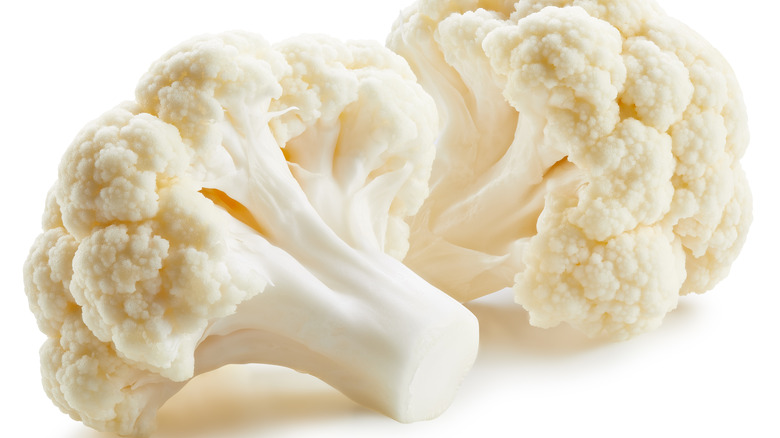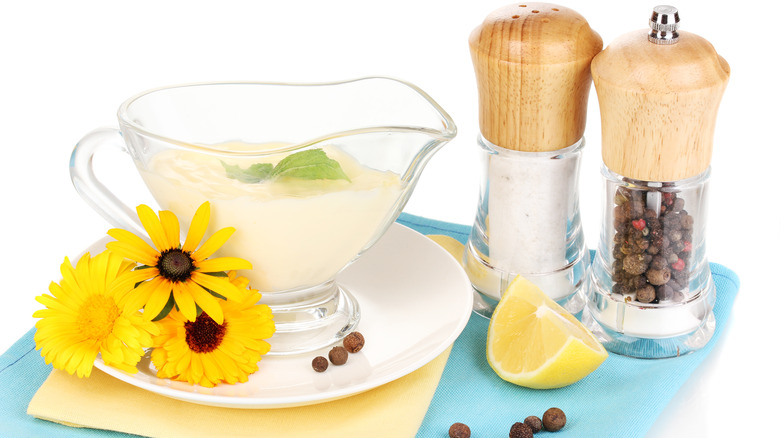Caulislaw Is Where Cauliflower Salad And Coleslaw Meet
There are all sorts of reasons to make caulislaw instead of regular coleslaw. Maybe you're tired of the same old cabbage salad, or perhaps you're looking for a new way to get a little bit more cauliflower in your diet. Perhaps you planned to make regular coleslaw with the head of cabbage in the crisper, but on closer inspection it turned out to be cauliflower. Or maybe you're just in the mood to try a new variation for fun. Whatever the reason, it's a worthwhile twist on a classic dish.
Caulislaw is just like coleslaw except it's made with cauliflower instead of cabbage; in other words, it's a cauliflower slaw. If you've ever had broccoli slaw then you get the basic idea, however, there is one key difference. Since cauliflower doesn't have an extensive stalk the same way that broccoli does, it's made from the florets. They give the salad an extra crunch, as well as a distinct mouthfeel that sets it apart from other types of slaw. Cauliflower is also milder than what you get with shredded cabbage and broccoli, with a slightly sweet nuttiness. All the same, it still has just enough of that sharp brassica pungency that's the key to a good slaw.
How to make cauliflower slaw
This salad is easy to make, considering it's basically the same process as making regular coleslaw. Cauliflower florets need to be chopped into small pieces, carrots should be shredded or julienned, and any additional veggies need to be cut up as well. You'll need to make a dressing (unless you prefer to add the individual dressing ingredients directly to the veggies before mixing). Once all the components are ready, everything needs to be tossed together to evenly combine the ingredients. When all of that is done, it's a good idea to let the salad marinate in the refrigerator before serving.
Naturally, the presentation is going to be slightly different from regular coleslaw. Even chopped up, cauliflower florets won't look much like shredded cabbage. There's no rule about how finely to cut the coleslaw florets, but they should be fairly small. Ideally, you don't want any chunks to be larger than a dime — though half that size would be best. As you cut, some of the cauliflower will crumble, which is fine. Those tiny pieces can still go in the salad. You can use a food processor as a shortcut, but go slowly to avoid ending up with only crumbs. The stems can be grated, but avoid doing so with the heads. As for the carrots, don't shred them too thinly either, as you want their crunch to hold up against the cauliflower. As with coleslaw, the ratio of cauliflower to carrots varies by taste.
Making the dressing and adding extras
Store-bought coleslaw dressing will work just fine for caulislaw, as will a traditional homemade concoction of mayo, vinegar, lemon juice, sugar, salt, and pepper. But why not step it up a notch with a little Dijon mustard? The tangy sharpness pairs brilliantly with the sweetness of the cauliflower. A bit of vanilla yogurt can also add zest and sweetness at the same time. Or go wild and try honey mustard. You can even switch out regular mayonnaise for curried mayo, herbed mayo, or spicy mayo if you dare. Try not to dress the salad too heavily, especially if you're grating the stems, since the softer shreds risk losing their crunch.
Capers and green olives pair well with cauliflower's slight sweetness, while diced dried plums match well with its bitter undertones. Walnuts enhance its natural nuttiness, and red onions complement each of those flavors well. Just be sure to slice them nice and thin so that they're not overpowering. Since spicy cauliflower is always a hit, you can't go wrong tossing in some hot peppers as well.
When it comes to cauliflower slaw, there's plenty of room for creativity and lots of ways to complement its unique mildly sweet yet bitter flavor profile with surprising ingredients. With so many fun possibilities, who knows what you might come up with once you get started? Like coleslaw, cauliflower slaw will stay good in the refrigerator for a few days.


